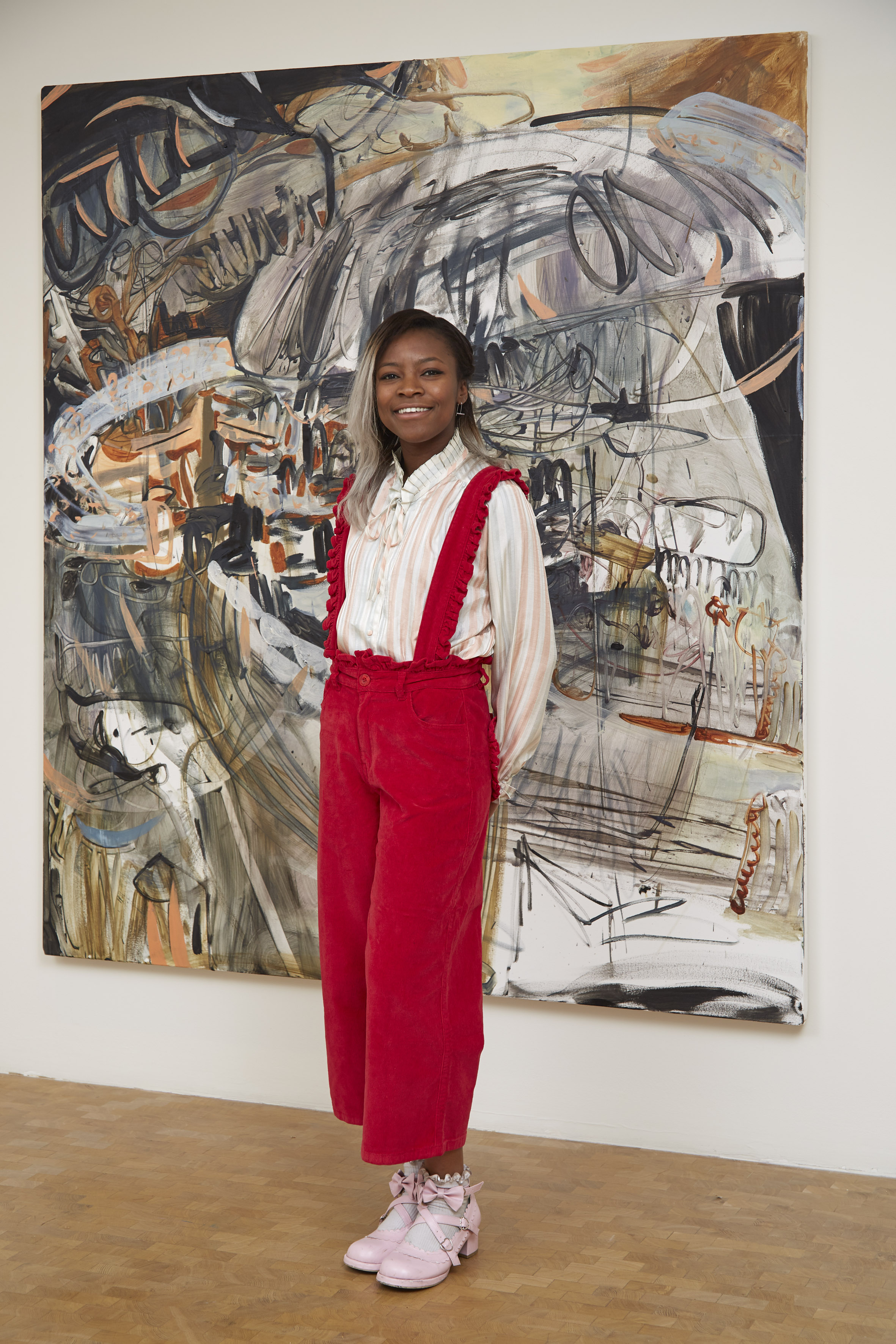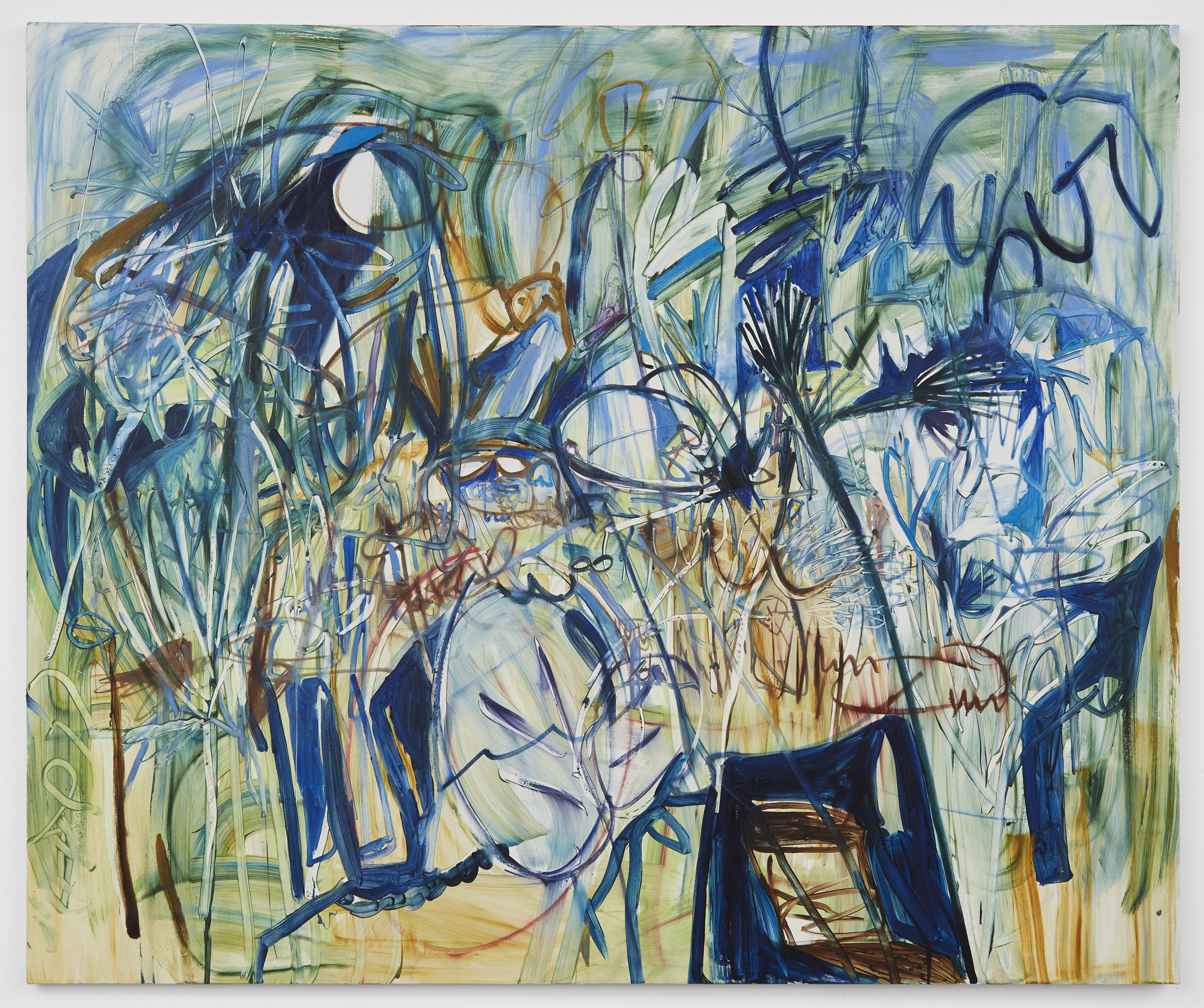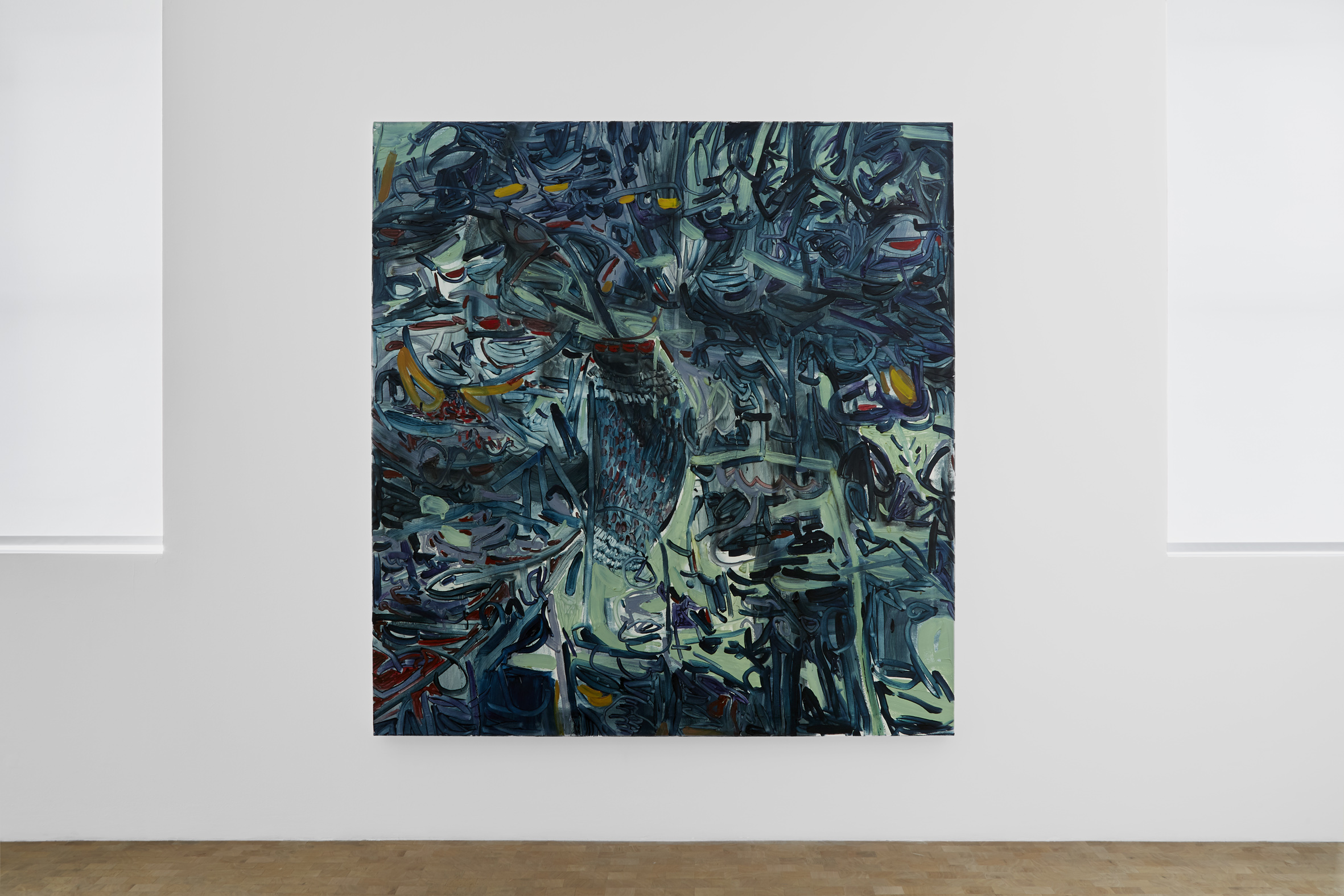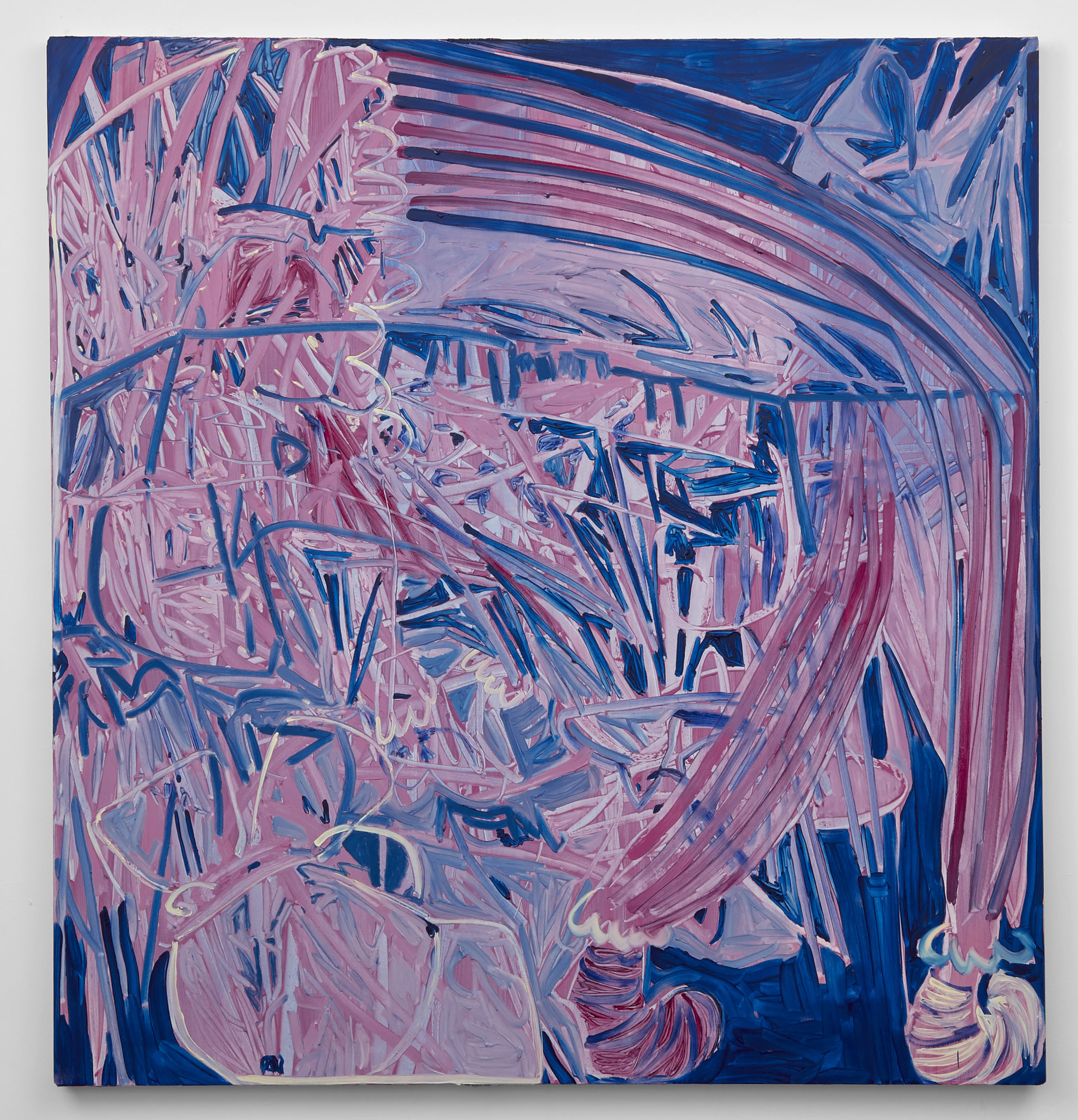 Jadé Fadojutimi’s vibrant, expressive paintings are rendered out of loose, translucent brushstrokes; the energetic conviction in her medium is palpable. “A tutor once told me that my marks felt hesitant. It really stuck with me. I now damage so many brushes because I’ve gone the complete opposite way. If I’m going to make a mark, I’m going to go for it!” laughs Fadojutimi when we meet at Heliophobia, her latest exhibition at Pippy Houldsworth Gallery in London. “One of my studio mates made fun of me, she said watching me paint is like watching me doing aerobics. I made a diptych recently and found myself taking run-ups! We had to make bubblewrap curtains as I splatter paint everywhere.” Over the last six months, Fadojutimi has been working from a large shared studio in Peckham. Selecting the space due to its large windows, she has watched the interior space change over the seasons. “In the summer it was green, and in autumn it changed to orange. When the sun sets, these big purple skies fill the window too.” Environment—and the incoming night—is crucial to her working process. “Environment is so important to me, it affects my mood so much,” she says. “I’m often kept up by my thoughts at night; I’m not very good at sleeping, so I make most of my works then. It’s when I feel the most absorbed in whatever I’m doing.”
Jadé Fadojutimi’s vibrant, expressive paintings are rendered out of loose, translucent brushstrokes; the energetic conviction in her medium is palpable. “A tutor once told me that my marks felt hesitant. It really stuck with me. I now damage so many brushes because I’ve gone the complete opposite way. If I’m going to make a mark, I’m going to go for it!” laughs Fadojutimi when we meet at Heliophobia, her latest exhibition at Pippy Houldsworth Gallery in London. “One of my studio mates made fun of me, she said watching me paint is like watching me doing aerobics. I made a diptych recently and found myself taking run-ups! We had to make bubblewrap curtains as I splatter paint everywhere.” Over the last six months, Fadojutimi has been working from a large shared studio in Peckham. Selecting the space due to its large windows, she has watched the interior space change over the seasons. “In the summer it was green, and in autumn it changed to orange. When the sun sets, these big purple skies fill the window too.” Environment—and the incoming night—is crucial to her working process. “Environment is so important to me, it affects my mood so much,” she says. “I’m often kept up by my thoughts at night; I’m not very good at sleeping, so I make most of my works then. It’s when I feel the most absorbed in whatever I’m doing.”

This tendency to work during the night connects to heliophobia, which is the innate fear of direct sunlight and bright light. “For me, there is something about rejecting sunlight which can mean rejecting positivity, or a fear of positivity,” Fadojutimi explains. “I actually think negativity can be such a positive thing.” She sees the dark earthy colours of the Heliophobia (2017) canvas as an “in the shade painting”. “I used to paint in pastels, but I think I got much moodier,” she tells me. However, the title of the show also has various layered meanings and associations that don’t strictly conform to the exhibition itself. “After I chose the title, it took on a life on its own, and I kept thinking about other things that could be related to it. As a child, I would always hate being in the sun, fearful of changing my appearance, or tanning, in case it would make me less beautiful, or a different person. That connection in itself is quite interesting. I often think about identity, and the things that we use to feel like ourselves—whatever that is.”
“It was actually liberating, to realize that you don’t know who you are—because there is no ‘who you are’—and to just think: ah, fuck it.”
Although the works appear objectively abstract at first glance, they have figurative elements disguised within them. Intertwined in the image are the outlines of objects and items important to Fadojutimi. However, they are kept deliberately secret from the viewer. “I hide a lot of things in my work. There is one recurring object in all my paintings,” she continues, adding pointedly, “but I’d rather not say what it is. It’s the most important object in my life, but it’s not important to the viewer.”

Most of Fadojutimi’s paintings are quick to produce, usually completed within one or two sessions, although she might struggle with the idea for a long time before. “My work isn’t improvised,” she clarifies. “I do a lot of drawing, I see a lot of things and I listen to a lot of things. They’re always brewing inside me before they’re ready to burst out. They might take a few hours but it’s taken a lot to get there.” She sees the experience of painting as a moment of questioning—using paint as a form of release, as a way to question perspectives in society and question her own sense of self. Clumsy (2017) is a unique painting in the show, due to Fadojutimi’s use of lapis lazuli and rose madden pigments. It also captures the idea of a moment perfectly. “I made this painting from 11pm to 5am,” she explains, “I went to sleep in the studio, and when I woke up and saw it, I just knew it was finished. Those are my favourite kinds of paintings. They feel more honest, they come from an instinctual feeling.”

Although there are these surreptitious images and personal resonances in the paintings for Fadojutimi, they are designed to be open and relatable for the viewer. “The self is so transient, we are very fluid beings, and we adapt to our conditions quickly.” She cites the feelings of displacement and a sense of not belonging during an artist exchange and residency in Kyoto, Japan as triggering the process behind this series of work. “When I went to Japan I felt frustration because I noticed a change in my character. I didn’t feel fully comfortable and I was in limbo. I’ve been there before, and I can speak the language—I’ve watched Japanese TV shows since the age of thirteen—so I felt like I had even less reason to experience those barriers. It was supposed to be my moment, to be there and to realize my dream, but instead, the dream just died very slowly over those three months,” she opens up. “It was a really nice process of dying. It was actually liberating, to realize that you don’t know who you are—because there is no ‘who you are’—and to just think: ah, fuck it.”
“A lot of my works are layered in what I am, or who I am. What I think things should be or shouldn’t be.”
This liberation of self allowed Fadojutimi to also liberate herself from her own artistic preconceptions. “Before, I was constantly looking at other people’s work and not developing what I was doing. Towards the end of the trip, I was so angry that I locked myself in my room for three days. I started working my way through a TV series, but I get distracted very easily, so I started drawing, going back and forth between the two. After a while, I had thirty drawings in front of me. They were akin to scribbles. I’ve always drawn this way but I had pushed it to the side, thinking that drawing always needed to be resolved. However, once you are confronted with that many images in front of you… I realized, oh, there I am, this is me, and I ended up finding my language.”

Themes of identity, self-knowledge and unresolved emotion reverberate throughout Fadojutimi’s exhibition. The paintings have such presence, speaking to one another and demanding space. “Painting fills the gaps in language. There is a lot that I can’t necessarily put into words,” she muses. “We respond in ways that we only know how. When I’m making a painting, unexplained emotions come out. Language acts as a barrier between the work and the person viewing it. Even if I tried to describe the paintings, I wouldn’t be able to do them justice. They do so much on their own.”
The work feels both familiar and unfamiliar, reality is obscured, our perception forced to take twists and turns when looking at them. “What I love about painting is that it can do something to you that you can’t really describe, and that is quite disturbing. What is the pull, what is the appeal?” There is direct feedback between the artist and the medium. “A lot of my works are layered in what I am, or who I am. What I think things should be or shouldn’t be,” she explains. “I have this quite perverse relationship with paint. I really envy it. It can talk better than I do.”





